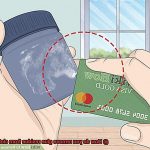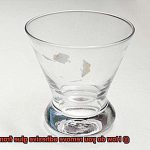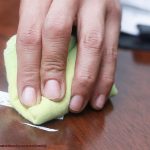Imagine this: you’ve just unwrapped a gorgeous piece of glassware or a shiny new mirror, only to be greeted by an annoying residue of stubborn adhesive. Ugh. Now you’re left wondering how on earth you can get rid of this pesky blemish without causing any damage.
But fear not, my friend, because today we’re embarking on a quest to uncover the secrets of fast adhesive removal from glass. Whether it’s a stubborn price tag that won’t budge, sticky residue from an old decal, or any other adhesive-related annoyance, we’ve got your back.
Let’s kick things off with a fun fact, shall we? Did you know that glass is particularly delicate when it comes to removing adhesive? Unlike other materials, it requires a gentle touch and precise techniques to avoid scratches or clouding.
In this captivating guide, we’ll explore countless methods to free your glass from those sticky bonds in no time. From the superhero-like powers of everyday household items to specialized commercial products, we’re leaving no stone unturned.
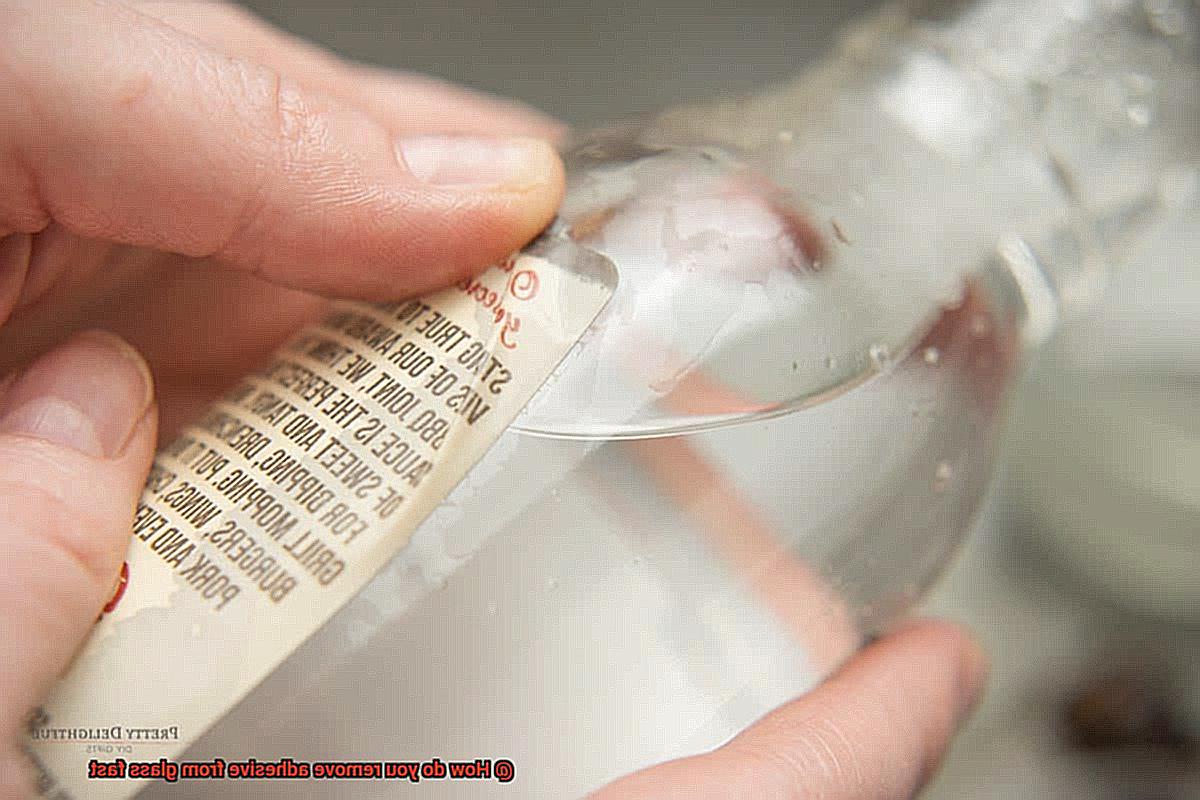
Get ready to discover the magical properties of substances like vinegar, rubbing alcohol, and even nail polish remover – each armed with their own unique abilities to dissolve adhesive deposits while leaving your glass sparkling like new.
Stay tuned for insider tips and tricks that include using heat as your secret weapon and harnessing the delicate yet potent powers of a trusty razor blade. We’ll also make sure you’re equipped with essential safety precautions for a successful adhesive removal experience every single time.
Say goodbye to the days of struggling with stubborn adhesives on glass. Join us on this enlightening journey and unlock the art of swift adhesive removal to restore your precious glass treasures to their former glory.
What is Adhesive?
Contents
- 1 What is Adhesive?
- 2 Types of Adhesive and Their Uses
- 3 The Soapy Water Method for Removing Adhesive from Glass
- 4 The Rubbing Alcohol or Nail Polish Remover Method for Removing Adhesive from Glass
- 5 The Vinegar Method for Removing Adhesive from Glass
- 6 Commercial Adhesive Removers
- 7 Tips and Precautions When Using Any of These Methods
- 8 Conclusion
Adhesive, also known as glue, is a remarkable substance that has the ability to unite two surfaces seamlessly. From everyday repairs to complex industrial applications, adhesive comes in various forms, each with its own unique properties and applications. This article will take you on a captivating journey into the world of adhesive, exploring its science, different types, and effective methods for removing it from glass.
The Science Behind Adhesive Bonding:
At its core, adhesive works by creating a molecular attraction between the adhesive itself and the surfaces it bonds. This attraction can be achieved through a variety of mechanisms, including chemical reactions, physical interactions, or a combination of both. It is this invisible force that allows adhesive to create strong and durable bonds between different materials.
Types of Adhesive:
- Epoxy Adhesives: Renowned for their exceptional strength and resistance to chemicals and heat, epoxy adhesives are favored in industrial applications. They form robust bonds on glass surfaces, making them ideal for projects that demand durability and reliability.
- Cyanoacrylate Adhesives (Superglue): With lightning-fast setting times and remarkable bonding properties on glass, cyanoacrylate adhesives are superheroes in the adhesive world. They are the go-to choice for quick repairs or small-scale projects where a strong bond is essential.
- Polyurethane Adhesives: Flexibility meets resilience in polyurethane adhesives. These versatile adhesives exhibit excellent resistance to water and weathering, making them perfect for outdoor or marine applications involving glass bonding. They stand strong even in the face of challenging environments.
- Silicone Adhesives: When flexibility and extreme temperature resistance are paramount, silicone adhesives come to the forefront. These adaptable adhesives are commonly used for sealing glass joints or bonding glass to other materials. They ensure a watertight seal and maintain their elasticity over time.
Removing Adhesive from Glass:
When it comes to bid farewell to adhesive on glass surfaces, here are some tried-and-true methods:
Soapy Water Method: Begin by filling a basin or sink with warm water and adding a few drops of dish soap. Submerge the glass item with adhesive and allow it to soak for 10-15 minutes. Gently scrub the area using a soft cloth or sponge, applying gentle pressure to safeguard the glass surface from scratches.
Types of Adhesive and Their Uses
The answer lies in the fascinating world of adhesives. These magical substances have the power to create strong bonds between different surfaces. In this article, we will explore the various types of adhesives used for bonding glass, delving into their unique characteristics and applications. Get ready to uncover the secrets of glass bonding.
Super Glue – A Speedy Solution:
Known as cyanoacrylate adhesive, super glue is a popular choice for bonding glass. This adhesive works like a charm, creating a strong and durable bond within seconds. Whether it’s joining glass to glass or glass to other materials, super glue is the go-to option. However, it’s important to note that it can leave behind a white residue on the glass surface, which may require additional cleaning.
The Unyielding Power of Epoxy:
When it comes to strength and chemical resistance, epoxy adhesives reign supreme. These adhesives consist of two components – resin and hardener – that are mixed before application. Epoxy adhesives are ideal for bonding glass to glass, metal, or other materials that require a robust bond. The slow curing time allows for precise positioning of the glass pieces before they set, ensuring a perfect fit.
Silicone – Flexibility in Extreme Conditions:
For situations that demand flexibility and resistance to high temperatures and moisture, silicone adhesives are the heroes. These versatile adhesives are commonly used for bonding glass to metal or plastic. Whether it’s attaching glass to bathroom fixtures or securing automotive windshields, silicone adhesives provide a strong bond that can withstand even the harshest conditions.
UV Curable Adhesives – A Bond at the Speed of Light:
In industries where rapid and precise bonding is essential, UV curable adhesives take center stage. These adhesives cure under ultraviolet light, forming a rapid bond. They are often used in electronics and optics, where speed and accuracy are paramount. UV curable adhesives offer excellent optical clarity, making them an ideal choice for bonding glass to glass or glass to plastic.
Hot Melt Adhesives – Quick Fixes with a Twist:
When it comes to temporary fixes or bonding glass to porous materials, hot melt adhesives come to the rescue. These solid adhesives are melted using a hot glue gun and quickly solidify upon cooling, creating a strong bond. While hot melt adhesives may not provide the same level of strength as other types, they are perfect for quick repairs or temporary bonding needs.
The Soapy Water Method for Removing Adhesive from Glass
Ah, the frustrations of sticky adhesive clinging to glass surfaces. Whether it’s a persistent sticker residue or an accidental adhesive mishap, removing it can be a daunting task. But fret not, my friends. I am here to unveil a simple yet powerful solution that will restore your glass to its pristine state – the enchanting Soapy Water method. So grab your supplies and prepare to immerse yourself in this effervescent adventure.
Supplies Needed:
Before we embark on our journey to conquer adhesive woes, let us gather all the requisites to ensure a successful mission. Here’s your checklist:
- Dish soap: Opt for a gentle variant that won’t harm your precious glass.
- Warm water: We shall require an ample amount to create a formidable soapy solution.
- Sponge or cloth: A soft and non-abrasive accomplice to perform its magic.
- Plastic scraper or credit card: Our trusty sidekick for delicately scraping off adhesive remnants.
Step 1: Crafting the Soapy Solution
Now that we are well-equipped, let us concoct our secret weapon – the soapy solution. Secure a bowl or bucket, fill it with warm water, and infuse it with a few drops of dish soap. Stir vigorously until the liquid transforms into a frothy elixir worthy of even the most skilled alchemist.
Step 2: The Soapy Water Baptism
With our potent elixir prepared, it is time to unleash its powers upon the adhesive afflicting our glass. Take your sponge or cloth and immerse it in the soapy water. Proceed to tenderly caress the adhesive, as if performing a rejuvenating spa treatment, allowing the soapy water’s essence to infiltrate every crevice.
Step 3: The Magic of Patience
Just like the art of infusing flavor into a dish, our soapy water requires time to work its enchantment. Grant it a few minutes to penetrate the adhesive, persuading it to relinquish its stronghold on the glass surface. Take this moment to recline, unwind, and let the soapy water weave its spell.
The Rubbing Alcohol or Nail Polish Remover Method for Removing Adhesive from Glass
Fear not, for I present to you the enchanting powers of rubbing alcohol and nail polish remover, ready to banish adhesive from glass like true sorcery. Prepare your cleaning cloths, for we are about to embark on a captivating journey into the world of adhesive removal.
Let us first acquaint ourselves with our trusty allies – rubbing alcohol and nail polish remover. These household heroes, readily available in every corner store or supermarket, possess the extraordinary ability to dissolve various types of adhesives. Rubbing alcohol, also known as isopropyl alcohol, is a versatile solvent capable of conquering adhesive enemies. Nail polish remover, or acetone, is a formidable contender crafted specifically for glass surfaces.
Before we dive into the exhilarating battle against adhesive, let us gather our tools. Take hold of a clean cloth or cotton ball and immerse it in either rubbing alcohol or nail polish remover. Now, prepare yourself for the thrilling confrontation with the adhesive.
With determination and grace, gently rub the adhesive-covered area on the glass using your soaked cloth or cotton ball. Witness the sheer magic as the rubbing alcohol or nail polish remover effortlessly breaks down the adhesive, rendering it vulnerable for removal. Should you encounter a stubborn foe that refuses to yield, fret not. Allow the rubbing alcohol or nail polish remover to dwell upon the battlefield for a few minutes, allowing it to penetrate the adhesive even further.
Congratulations on your triumphant victory over the adhesive. But our quest is not yet complete – there remains a task to cleanse the aftermath. Seize a clean cloth or paper towel and wipe away any remnants of the defeated adhesive. Depending on the tenacity of the adversary, you may need to repeat this process multiple times until your glass shines with newfound brilliance.
However, take heed when wielding nail polish remover. This mighty warrior should only be deployed upon glass surfaces, sparing delicate materials such as plastic or painted surfaces from its potentially damaging effects. Let us prioritize safety, dear comrades.
As the final step in this remarkable journey, it is of utmost importance to thoroughly cleanse your glass surface with soap and water. This meticulous act ensures the eradication of any lingering traces of solvent, leaving your glass resplendent and free from the clutches of adhesive.
The Vinegar Method for Removing Adhesive from Glass
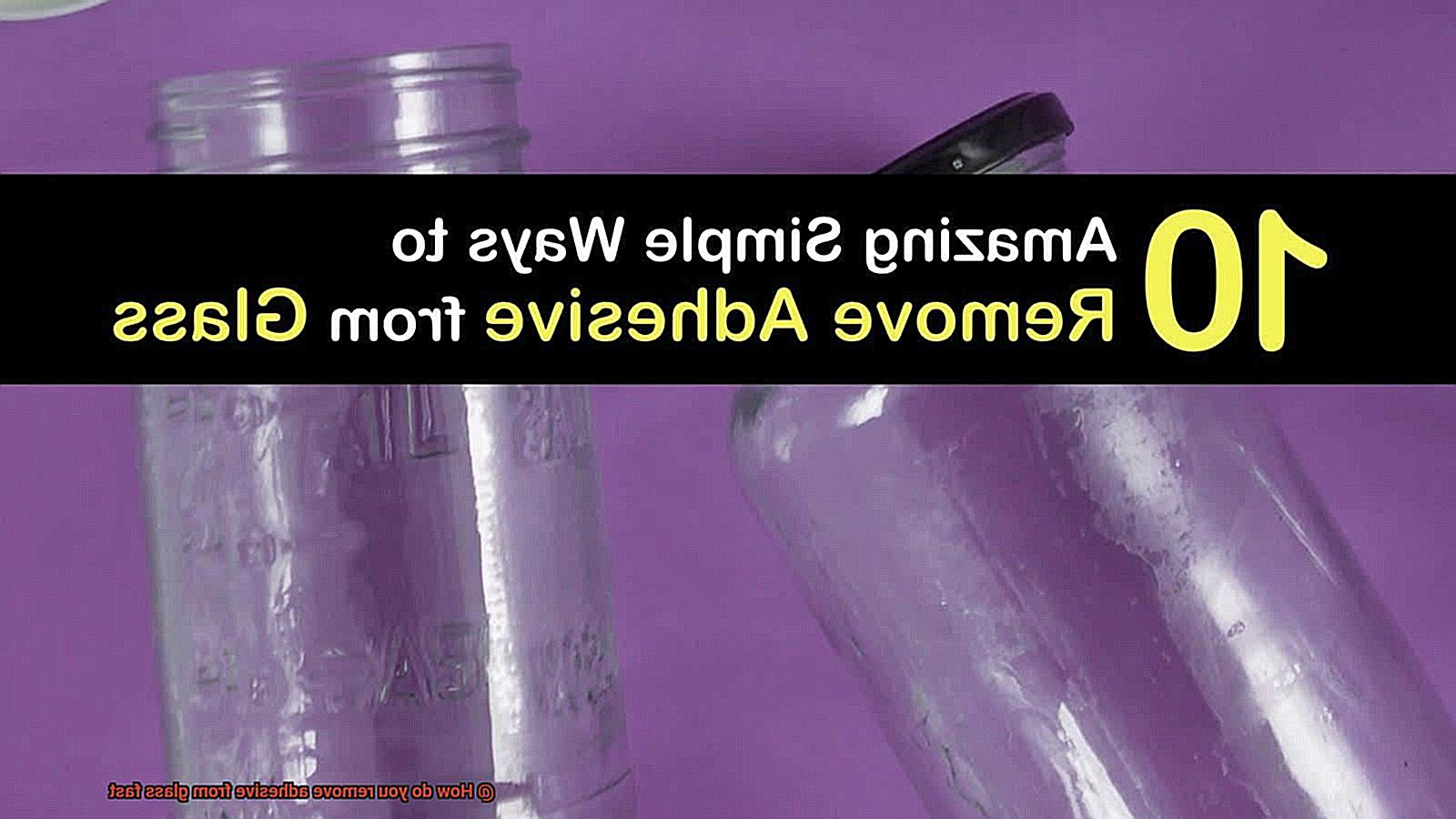
Fear not. I present to you the magical solution – the vinegar method. This tried and tested technique is not only effective but also safe, affordable, and easily accessible. So, grab your spray bottle and let’s embark on a captivating journey into the realm of vinegar.
Step 1: Gather Your Tools
Prepare for this enchanting adventure by gathering these essentials:
- White vinegar: The star of our show, this natural and non-toxic solution effortlessly breaks down adhesive without harming your glass.
- Spray bottle: Your trusty companion for dispensing the vinegar onto the glass surface.
- Clean cloth or sponge: This loyal ally aids in scrubbing away the adhesive.
- Warm water: A gentle accomplice in rinsing off any vinegar residue.
Step 2: Preparing the Vinegar Potion
Equip your spray bottle with white vinegar. Customize your potion by using it undiluted or mixing it with equal parts of water for a gentler solution. Experiment and find the perfect blend for your needs.
Step 3: Unleashing the Vinegar’s Power
Now, let us harness the power of vinegar to conquer that stubborn adhesive:
- Direct your spray bottle at the adhesive area on the glass, generously dousing it with vinegar. Ensure complete coverage to maximize effectiveness.
- Allow the vinegar to work its magic for approximately 10-15 minutes. During this time, it will seep into the adhesive, weakening its grip and making removal effortless.
Step 4: The Scrubbing Spell
Armed with a clean cloth or sponge, unleash your scrubbing prowess upon the adhesive. Witness how effortlessly it surrenders to your touch, as if under a mystical spell. For relentless residues, spritz more vinegar and grant it a few extra minutes to work its charm before resuming your scrubbing.
Step 5: Rinsing Away the Residue
Having successfully banished all traces of adhesive, it is time to cleanse:
- Position your glass surface under a stream of warm running water, ensuring thorough rinsing to wash away any lingering vinegar.
- This cleansing ritual eliminates any residue and unveils a glass surface that gleams like a radiant gem.
Commercial Adhesive Removers
Glass surfaces exude elegance and sophistication, but stubborn adhesive residue can mar their pristine beauty. Fear not, for I am your friendly expert on commercial adhesive removers, here to unveil the secrets of effortlessly restoring your glass surfaces to their former sparkling glory. So sit back, relax, and embark on this enchanting journey with me.
The Power of Commercial Adhesive Removers:
Commercial adhesive removers are like little wizards, specifically crafted to banish sticky adhesive residue from various surfaces, including glass. These magical products are formulated with potent chemicals that work their sorcery by breaking down adhesive bonds, making removal a breeze.
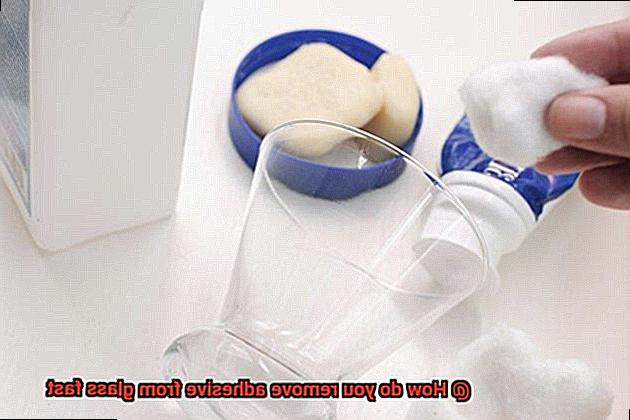
Choose Your Potion:
Just as wizards have different spells for different tasks, commercial adhesive removers come in various forms to cater to your specific needs. Sprays, gels, liquids, and handy wipes are at your disposal, allowing you to select the potion that resonates with your inner sorcerer.
The Art of Application:
Before we delve into the spellbinding process of removing adhesive from glass using a commercial adhesive remover, it’s crucial to don our wizarding gear and take precautions. Carefully read and follow the instructions provided by the manufacturer. Wear protective gloves and work in a well-ventilated area to minimize exposure to the magical chemicals.
Testing and Compatibility:
As true wizards test their magic before casting it on a grand scale, we should do the same. Apply a small amount of the adhesive remover on an inconspicuous area of the glass to ensure compatibility and avoid any unwanted surprises. Once you’re confident it’s safe, let’s move on to the main event.
Unleashing the Magic:
Now, behold the true power of commercial adhesive removers. Apply a generous amount of the product onto the adhesive residue and let it work its charm for a few minutes. This allows the remover to penetrate and loosen those stubborn adhesive bonds.
The Gentle Scrub:
Once the remover has worked its magic, grab a soft cloth or sponge and gently scrub the area in circular motions. This motion helps lift off the residue without causing harm to your precious glass surface. For extra-stubborn or thick layers of adhesive, you may need to repeat the process or employ a scraping tool specifically designed for glass surfaces.
Tips and Precautions When Using Any of These Methods
Removing adhesive from glass surfaces can be a challenging task, but with the right precautions, it can be done safely and effectively. In this section, we will highlight the importance of taking proper precautions when using any adhesive removal method. By following these tips, you can protect yourself, prevent damage to the glass, and achieve successful adhesive removal.
Prioritize Personal Safety:
Before diving into the adhesive removal process, prioritize your safety by wearing protective gloves and goggles. Chemical-based adhesive removers may contain potentially harmful substances that can irritate the skin or eyes. By donning the appropriate protective gear, you minimize the risk of direct contact and potential harm.
Test on a Small Area First:
To avoid any unpleasant surprises, always test the adhesive remover on a small, inconspicuous area of the glass before applying it to a larger surface. This simple step allows you to assess compatibility and potential damage or discoloration caused by the remover. If there are no adverse effects after a few minutes, proceed with confidence.
Exercise Patience and Gentle Handling:
Removing adhesive from glass surfaces requires patience and a gentle touch. Rushing through the process may result in accidents or further damage to the glass. Take your time and apply gentle pressure while scrubbing or scraping off the adhesive. Opt for plastic scrapers or soft cloths to minimize the risk of scratching or marring the glass surface.
Adhere to Manufacturer’s Instructions:
Each adhesive remover may have specific instructions for safe and effective use. It is crucial to carefully read and follow these instructions provided by the manufacturer. Doing so ensures that you use the product correctly and achieve optimal results without compromising your safety or damaging the glass surface.
Thoroughly Clean After Removal:
Once you have successfully removed the adhesive residue, it is essential to clean the glass surface thoroughly. Any leftover adhesive or adhesive remover can attract dust and dirt, making your efforts futile. Use a mild detergent or glass cleaner to ensure the glass is clean, clear, and free from any residue.
dIUTLxuJWBI” >
Conclusion
Removing adhesive from glass can be a frustrating task, but with the right techniques, you can tackle it quickly and effectively.
There are several methods you can try, such as using rubbing alcohol or vinegar to dissolve the adhesive. Another option is to use a razor blade or scraper to gently scrape off the residue.
Whichever method you choose, be sure to take precautions and protect yourself by wearing gloves and working in a well-ventilated area.


